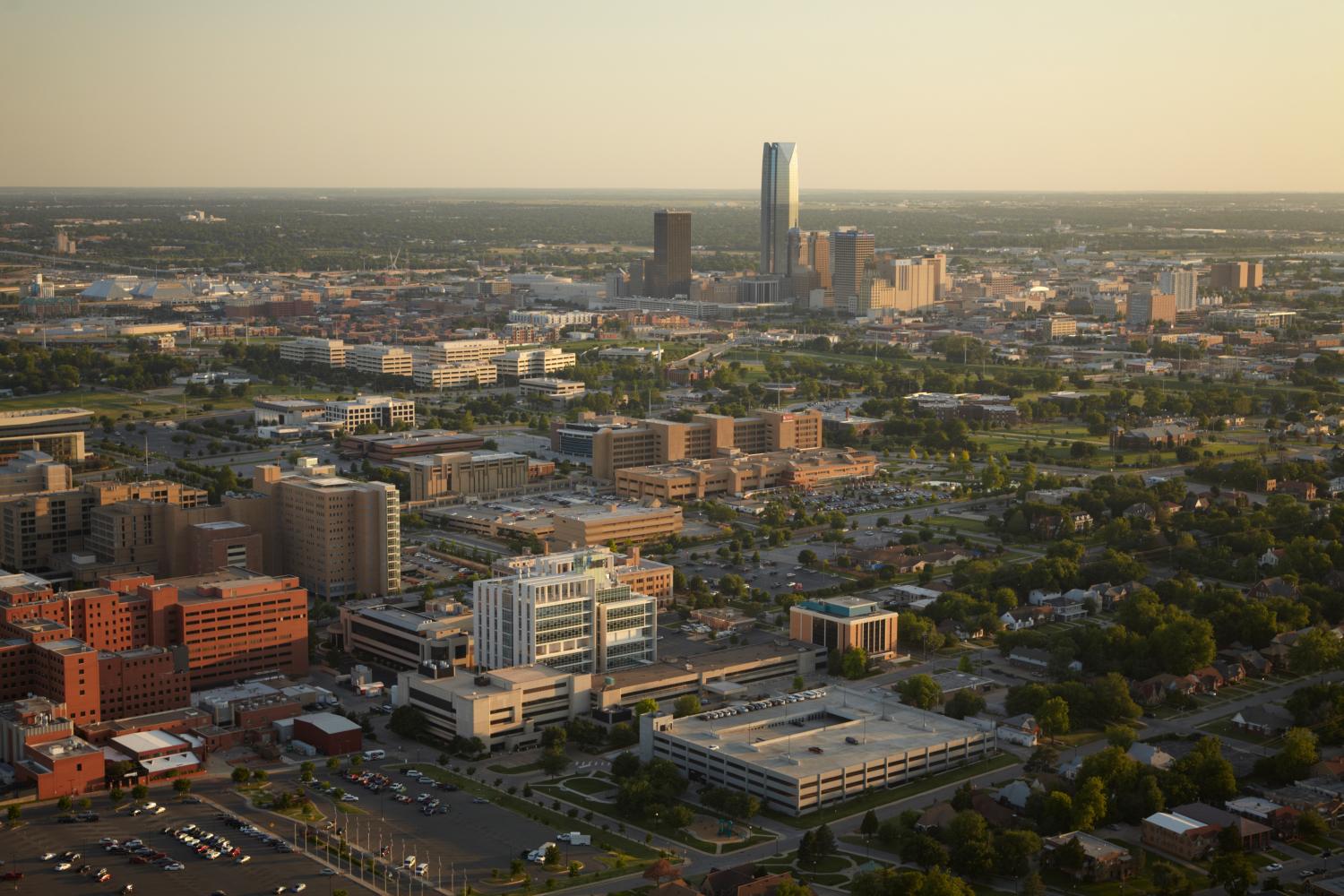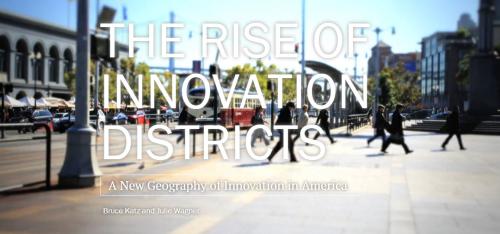In today’s global economy, cities rise above international competitors—or not—based on their ability to innovate not within single industries—autos, steel, energy—but rather by finding new points of convergence across them.
The implications of this new competitive landscape for Oklahoma City are significant. Two of the region’s largest economic clusters—energy and health care—are undergoing substantial disruption. The expansion of North American natural gas has opened the energy economy to new players. In health care, life science breakthroughs are coupling with information technology in areas like personalized medicine and health IT to redefine the care continuum, creating wide openings for technology and life science capitals like Austin, Texas; Boston; and San Francisco.
Yet as crosscutting technologies—from “big data” to sensing—expand the competitive playing field in industries critical to Oklahoma City, they also create unprecedented opportunity for the region to vault ahead of its peers.
This great leap will not happen spontaneously, however. To leverage advantages in health, energy, and other sectors, Oklahoma City’s public and private leaders need to take action to improve joint industry-relevant research; grow, attract, and retain new technology companies; and ensure that the workforce is prepared for future jobs. They need to invest in creating dynamic, high-quality places where research institutions, firms, and talent concentrate and connect. And they need to nurture the talents and potential of low-income residents, who, if history is any lesson, will otherwise remain disconnected from the innovation economy’s growth.
The Oklahoma City metropolitan area has long-standing industry strengths and assets on which to build a new convergence economy. The region dominates in oil and gas extraction, and it is becoming a global center for advanced energy technology, evidenced by the recent opening of the General Electric (GE) Global Research Oil & Gas Technology Center. Outside of energy, the region has economic strengths in aerospace engineering, led by Tinker Air Force Base, Boeing, and Northrop Grumman, and in health care, driven by the University of Oklahoma Health Sciences Center (OUHSC), the Oklahoma Medical Research Foundation (OMRF), and several private-sector firms, including COARE Biotechnology, Charlesson, and Selexys.
The new GE facility and these health care assets largely concentrate in Oklahoma City’s emerging innovation district. Bounded roughly by Robinson and Lottie Avenues to the west and east and 4th and 13th Streets to the south and north, this 1.3-square-mile area encompasses both the Oklahoma Health Center and the vibrant commercial corridor of Automobile Alley. A significant center of job growth, the district reflects the shifting geography of the global economy and the emergence of dense hubs of economic activity where innovation, entrepreneurship, creativity, and placemaking intersect.
With the right investments, the Oklahoma City innovation district has the potential to become a major center of gravity for innovation and economic development in Oklahoma City.
With the right investments, the Oklahoma City innovation district has the potential to become a major center of gravity for innovation and economic development in Oklahoma City.
Oklahoma City’s innovation district is already a vital part of the region’s innovation economy. Over 18,000 people work in the area, almost 5 percent of the city’s total. Its cluster of medical and research institutions attracts three-quarters of the project dollars the state receives from the National Institutes of Health, and its improved commercialization outcomes, coupled with the presence of business support organizations like i2E, position it to become the region’s hub of entrepreneurial activity. Furthermore, the district’s proximity to downtown—which is home to several major energy company headquarters—and other areas of growth give it a powerful locational advantage. Though only about 1,200 people live within the district itself, the neighborhoods to the west and south, such as Bricktown and Deep Deuce, have enjoyed a noticeable uptick in housing values, development, and amenities.
For all its strengths, however, the district yet to tap its full potential, and it faces a number of challenges in terms of innovation, place, and inclusion:
- Innovation challenges: A historically medical-centric area, the district has neither the density nor diversity of institutions, firms, startup companies, and innovations spaces that many of its peers possess. And while many of the area’s health care and energy institutions and firms are physically close to one another, few organizing structures exist to strategically connect these industries—to one another and to other regional assets in Norman and elsewhere—around common technology platforms.
- Place-related challenges: The district’s car-centric physical layout and lack of gathering spaces hinder companies and workers from taking advantage of their proximity to interact, exchange ideas, and build collaborative networks. Meanwhile, limited walkability in and around the district makes the more amenity-rich areas nearby feel further away than they actually area. Such place-related drawbacks may impede the ability of district firms and institutions to attract young talent.
- Inclusion challenges: Though well-paying jobs exist in the district for workers with varying education and skill levels—roughly 55 percent of district jobs do not require a four-year degree—the low-income residents of neighboring communities remain largely disconnected from employment within the district.
Oklahoma City’s innovation district concentrates innovation and technology assets that could propel the region into global prominence within a range of converging technologies, particularly those related to health and energy.
Oklahoma City’s innovation district concentrates innovation and technology assets that could propel the region into global prominence within a range of converging technologies, particularly those related to health and energy. But reaching this potential will require that district and Oklahoma City leaders address the area’s challenges and collectively define and support a new vision and set of strategies to create a dynamic, inclusive hub of innovative and entrepreneurial activity.
To this end, this report recommends four multifaceted strategies around which innovation district anchor institutions, firms, and civic leaders should rally city and regional stakeholders to engage with their time, expertise, and resources:
- Establish an Oklahoma Center for Energy and Health Collaboration that serves as the physical and programmatic umbrella for innovation and applied research within these and other sectors. The center would be a staged, multitiered initiative that supports the collaboration between prominent but currently disjoined economic clusters, beginning with energy and health care and eventually expanding to other clusters such as aerospace. The district should become the central hub of collaboration by securing space for the new center and attracting strategic partners, including corporate anchors, faculty from external universities, and entrepreneurs. The center should also house a translational research and commercialization office for crosscutting industry applications of research.
The new center would likely be initially funded and operated by the overarching governance structure of the district, but eventually—as regional energy companies and universities outside the district begin to partner with the center on translational research—a coalition of internal and external organizations should emerge to help set the center’s agenda and direction.
- Implement a technology-based economic development and entrepreneurship effort within the innovation district specifically tasked with overseeing strategic business development, technology business attraction, marketing, and regional cluster development between entrepreneurs, small and medium-sized enterprises, and large firms. This new effort should serve as a conduit between market-oriented entities in the district like i2E, which works with entrepreneurs, researchers, and companies to help them commercialize their technologies and grow new businesses. Finally, an innovation district seed fund and tailored accelerator would go a long way toward helping research entrepreneurs access early-stage capital for prototyping and market testing.
This effort likely does not require a new institution. Instead, existing organizations could coordinate and be tasked and resourced to focus on economic development and entrepreneurship activity within the district.
- Create a denser, more active, and better-connected mixed-use urban environment in and around the innovation district, an essential complement to the actions recommended above to build a collaborative network among institutions and companies to spark innovation and firm development. To do so leaders should undertake new land use and real estate development efforts that will provide the types of commercial and residential uses, whether in new infill development or in existing buildings, that will lead to a more vibrant, sociable, and around-the-clock district environment; implement new placemaking efforts such as lectures, networking activities, food events and festivals, outdoor performances, recreational activities, health fairs, and opportunities for outdoor play; strengthen connections between the Health Center and Automobile Alley via new landscaping, lighting, and other pedestrian improvements on NE 10th and NE 13th Streets and on the bridges over Interstate 235, and by new development along 10th Street; improve bike and pedestrian routes within the Health Center to allow for easier access between parking lots and workplaces and between workplaces and new destinations (such as programmed public spaces); and make the innovation district more porous and connected to residential neighborhoods.
- Form a standing committee on diversity and inclusion charged with overseeing the design of strategies aimed at forging better economic, social, and physical connections between the innovation district and the underserved communities surrounding it. The committee would comprise and/or work more broadly with representatives from the district’s institutional and private-sector stakeholders; education providers such as Oklahoma City Public Schools, local community colleges, and technology (CareerTech) centers; area workforce entities; and the nonprofit community, including neighborhood groups. The committee would focus on issue areas like education, workforce development, entrepreneurship, and placemaking/neighborhood development; guide and oversee goal and strategy development; and serve as a liaison between parties to facilitate alignment and coordination of efforts. The committee would also evaluate proposals and make funding recommendations.
Finally—and as called for in the Oklahoma Regional Innovation District Project Plan—district leaders need to establish a new type of governance entity that gives voice to the district’s narrative, defines what the district should aspire to become, and works with other area stakeholders to determine what innovation, place, and inclusion strategies it needs to employ as a unified place so as to have maximum collective impact on the city and region.
Whether Oklahoma stakeholders decide to create a new organization or repurpose an existing one, they have a chance to be trailblazers in establishing an entity that has a singular focus on the district and undertakes all the responsibilities that task entails. Such an entity does not need an army of dedicated staff, but it must have:
- an executive director who understands the innovation ecosystem and has the ability to coordinate actors both within and outside of the district around defined goals and strategies;
- a leadership structure (a board or steering committee) with the influence and authority to rally critical stakeholders and guide district efforts;
- discrete committees (e.g., on diversity and inclusion) and/or standalone initiatives (e.g., the Oklahoma Center for Energy and Health Collaboration) that will develop and drive key strategies;
- the staff capacity needed to support and coordinate the board, committees, and initiatives; interact with district and non-district stakeholders (including regional industry leaders, local government, the Urban Renewal Authority, neighborhood organizations, etc.); develop, implement, and align district-wide programs, land use planning, and placemaking activities; and raise funds.
Most importantly, this entity requires a strong innovation team (or at minimum a high-level leader) that sits between institutions and can catalyze a shared vision that holds a strong value proposition for each individual actor. Fulfilling this role will require a scientific understanding of the research portfolio and the ability to identify external partners, market opportunities, and funding opportunities.
Oklahoma City is poised to organize itself to be a fierce competitor in the innovation economy and to build a stronger regional economy as a result—if it has the vision and will to do so. The city has demonstrated its capacity to coalesce around bold ambitions before, rallying to build the Oklahoma City National Memorial and Museum, investing in its downtown, and passing multiple rounds of the Metropolitan Area Projects (MAPS) initiative to finance major redevelopment, infrastructure, and school improvements. It is again time to channel that collective spirit to grow a more inventive, entrepreneurial, and inclusive Oklahoma City economy.



![[picture courtesy of PPS] Anna Siprikova, project associate at Project for Public Spaces](https://www.brookings.edu/wp-content/uploads/2017/04/anna_siprikova_pps_002.jpg?quality=75&w=222)

![[picture courtesy of PPS] Meg Walker, senior vice president at Project for Public Spaces](https://www.brookings.edu/wp-content/uploads/2017/04/meg_walker_2.jpg?quality=75&w=250)


![An aerial view of the Philadelphia innovation district [photo credit: SHoP Architects/West 8]](https://www.brookings.edu/wp-content/uploads/2017/05/philadelphia_idreport_webbanner001.jpg?quality=75&w=500)



